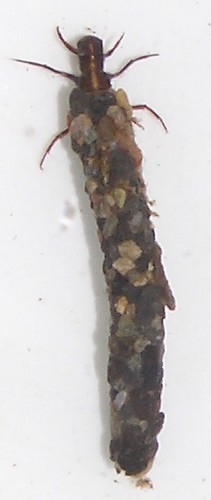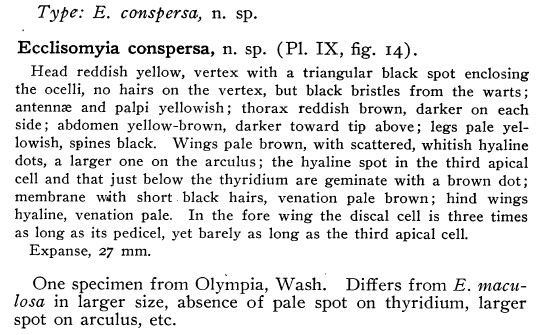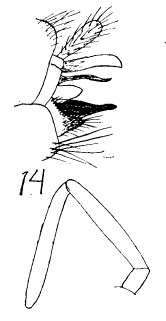Trichoptera: Limnephilidae of Gunnison County, ColoradoEcclisomyia conspersa(Banks) 1907Updated 1 March 2024

The Ecclisomyia sp. on the right was found in a small tributary to the upper East River on the 1st of June in 2007. Both E. conspersa and E. maculosa have a light-colored stripe as you can see on this animal. Good LinksOn this website:Introduction to Limnephilidae Other Websites: University of Alberta Entomology Collection Species page Has description, habitat information, range and more. ReferencesBanks, N. 1907. Descriptions of new Trichoptera. Proceedings of the Entomological Society of Washington 8:117-133.

Walter,JK; Bilby,RE and Fransen,BR 2006 Effects of Pacific salmon spawning and carcass availability on the caddisfly Ecclisomyia conspersa (Trichoptera: Limnephilidae). Freshwater Biology, 51(7), pp.1211-1218. PDF Cummins,KW; Wilzbach,MA; Gates,DM; Perry,JB and Taliaferro,WB 1989 Shredders and riparian vegetation. BioScience, 39(1), pp.24-30. PDF Demi,LM; Hughes,D and Taylor,BW 2022 Characterizing the role of phosphorus availability and periphytic algae in the food choice and performance of detritivorous caddisflies (Trichoptera: Limnephilidae). Freshwater Science, 41(1) 18-32. PDF Abstract: "Organisms that rely on detritus as their primary food source may face particularly strong nutritional constraints on growth and development, given the characteristically poor quality of detrital resources. In freshwater ecosystems, the low content of P in detritus often limits detritivore growth. Additionally, a growing body of evidence suggests the biochemical composition of algae, such as essential fatty acids, can limit aquatic detritivore growth. We investigated feeding preference and growth responses of common aquatic detritivores by performing paired feeding-preference and growth experiments on 4 species of larval caddisflies (Trichoptera) from the family Limnephilidae: Asynarchus nigriculus, Anabolia bimaculata, Limnephilus externus, and Ecclisomyia sp. We manipulated both the P content and epiphytic algal biomass of a common detrital food resource (decomposing sedge [Carex sp.]) by conditioning the detritus under 2 different light (ambient, shaded) and P (ambient [low], +P) regimes. We tested 3 hypotheses that describe feeding preferences and performance under different scenarios of P limitation, algal limitation, and co-limitation by P and algae. We observed evidence of preferential feeding behavior for each of the 4 taxa, with 2 species exhibiting preferences for conditioned detritus with high algal biomass and 2 for detritus from the +P treatments. We observed agreement between feeding preferences and performance (growth, growth efficiency, mortality) for only 2 taxa, with A. nigriculus exhibiting higher growth rates and growth efficiency on their preferred high- P detritus, and L. externus experiencing lower mortality when reared on their preferred high algal biomass detritus. These findings provide an initial step toward characterizing the feeding preferences and performance responses of aquatic detritivores to 2 potentially common nutritional constraints: detrital P and algal supply." Flint,OS, Jr. 1960 Taxonomy and biology of Nearctic limnephilid larvae (Trichoptera), with special reference to species in eastern United States. Entomologica American 40:1-117. Has description of larvae. Givens,DR 2018 The Nearctic Ecclisomyia species (Trichoptera: Limnephilidae). Zootaxa, 4413(2), pp.201-259. Abstract: " The Nearctic species of Ecclisomyia are reviewed with new descriptions of the pupae of the four recognized species. The larvae of E. bilera Denning 1951, E. maculosa Banks 1907, and E. simulata Banks 1920 are described. A supplementary description is provided for the larva of E. conspersa Banks 1907. Genetic and morphological information is provided to support the recent restoration of E. simulata as a valid species. Keys to the males, females, pupae, and larvae are provided. Biological and distributional data are also included." Herrmann,SJ; Ruiter,DE and Unzicker,JD 1986 Distribution and records of Colorado Trichoptera. Southwestern Naturalist 31 4, 421-457. Notes that Ecclisomyia conspersa lives in Gunnison County. Irons,JG III 1988 Life history patterns and trophic ecology of Trichoptera in two Alaskan (U.S.A.) subarctic streams. Canadian Journal of Zoology, 66:1258-1265. Abstract Ross,HH 1950 Synoptic notes on some nearctic Limnephilid caddisflies (Trichoptera:Limnephilidae). American Midland Naturalist 43 2, 410-429. Has diagnostic characters for Ecclisomyia males. Walter,JK; Bilby,RE and Fransen,BR 2006 Effects of Pacific salmon spawning and carcass availability on the caddisfly Ecclisomyia conspersa (Trichoptera: Limnephilidae). Freshwater Biology, 51(7), pp.1211-1218. PDF Summary: "1. The effects of spawning coho (Oncorhynchus kisutch) and chum salmon (Oncorhynchus keta) on the limnephilid caddisfly Ecclisomyia conspersa were evaluated by experimentally excluding salmon from the upper 14-m stretch of a spawning channel by a wire-meshed fence. Density, and development and growth rates, of larvae upstream of the fence (without salmon) were compared with those downstream (with salmon). 2. Larval density in the stretch with salmon declined during spawning, but increased again after spawning subsided and the carcasses of dead fish became available. In the stretch with salmon, larval density on salmon carcasses was seven to 37 times greater than on the adjacent channel substratum. The rate of larval development in the stretch with salmon was greater than that in the stretch without salmon. Two months after carcasses became available, 98% of larvae sampled from the stretch with salmon were in the fifth instar, compared to only 23% from the stretch without salmon. Body weight of E. conspersa in the stretches with and without salmon increased by an average of 3.04 and 2.38 mg, respectively, over a 6-month period. 3. 15 N values of larvae from the stretch with salmon increased following the arrival of the fish, suggesting that the larvae were feeding on salmon-derived material, such as eggs and carcasses, which contain a high proportion of the heavier stable isotope. In contrast, 15 N values of larvae from the stretch without salmon remained relatively constant throughout the experiment. The availability of salmon carcasses as a high-quality food source late in larval development may increase survival and fecundity of E. conspersa. 4. These substantial differences were consistent with the view that they were due to the experimental exclusion of salmon and salmon carcasses from the upstream stretch, though the study was un-replicated and thus precludes ascribing causation more definitely." Wisseman,RW 1987 Biology and distribution of the Dicosmoecinae (Trichoptera: Limnephilidae) in western North America. MS thesis Oregon State University. 137 pages PDF |